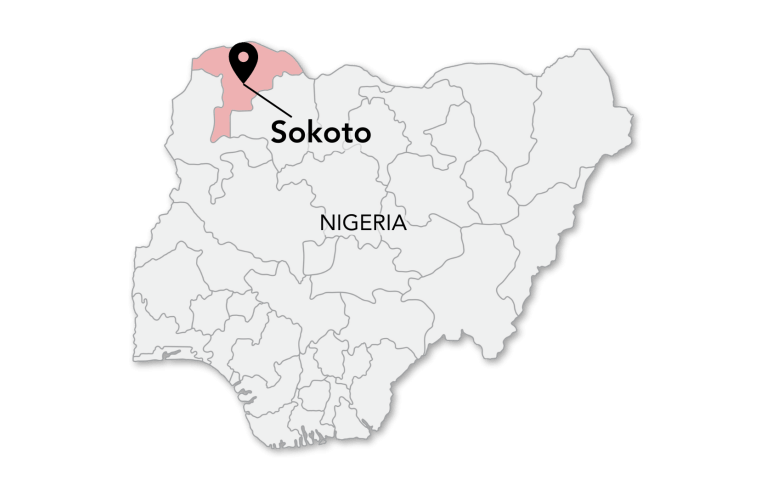Ten years ago, Doctors Without Borders/Médecins Sans Frontières (MSF) teamed up with the American and British Red Cross and OpenStreetMap to launch Missing Maps, an initiative enabling volunteers to support our work by collecting geodata for regions where vulnerable communities live. This information is a critical factor in the efficacy of humanitarian responses, and one that is often lacking in places where vulnerable communities live.
As we continue working to fill the gaps in mapping data around the world, we're ringing in Missing Maps' 10th birthday with MSF Geo Week Global Mapathons from November 18-23. On November 19, we're mapping communities on the outskirts of Sokoto, Nigeria, where noma and malnutrition pose a serious risk to people, especially those living in poverty and children. RSVP here to take part—no experience required.

At a glance
What’s happening in Sokoto?
Sokoto is located in northern Nigeria, where conflict has displaced thousands, cutting off access to food, livelihoods, and medical care. The region has been facing a dire malnutrition crisis in recent years, particularly affecting children, as well as the bacterial disease, noma. MSF has been working in Sokoto since 2014, with teams providing reconstructive surgery, nutrition, and mental health care for noma patients, and treatment for children with malnutrition in the region.


Left: A team of surgeons, anesthesiologists, and nurses carry out reconstructive surgery at Sokoto's noma hospital; © Alexandre Marcou/MSF. Right: two mothers meet with a mental health educator in the intensive care unit at MSF's inpatient nutrition hospital in Maiduguri, also in northern Nigeria; © Abba Adamu Musa/MSF.
Noma: A deadly neglected tropical disease
Noma is an infectious but non-contagious bacterial disease that starts as an inflammation of the gums, similar to a small mouth ulcer. The infection destroys the bone and tissue very quickly, affecting the jaw, lips, cheeks, nose or eyes, depending on where the infection started. People living in poverty are the most vulnerable, especially children under 7 years old. Without antibiotics, 90 percent of people with noma die within two weeks, and those who survive often face a future of pain, discomfort, and social stigma.
Last year, following years of campaigning by MSF and other actors, the World Health Organization added noma to its list of neglected tropical diseases—a welcome decision that will help devote the attention and resources needed to address the disease.
How Missing Maps works
- Take satellite or aerial photo of a place and trace features—like roads, buildings, and rivers—based on what the map will be used for.
- Enter this newly created data into OpenStreetMap, a free, open, and crowd-sourced platform.
- The data is sent to local communities to verify landmarks and add firsthand knowledge such as road names, settlements, and administrative divisions—whatever it takes to make that map something we can use to find and help people in need.
Malnutrition crisis
MSF teams in northwestern Nigeria, where Sokoto is located, have seen an alarming surge of malnutrition cases including an extraordinary increase in admissions of severely malnourished children with life-threatening complications. In Sokoto, our teams recorded a staggering 100 percent increase in cases at MSF inpatient facilities in April.
“We've been warning about the worsening malnutrition crisis for the last two years,” said Dr. Simba Tirima, MSF country representative in Nigeria. “2022 and 2023 were already critical, but an even grimmer picture is unfolding in 2024. We can't keep repeating these catastrophic scenarios year after year.”
People in this region often cannot access food or medical care as the instability has inhibited access to farmlands for food, and armed groups regularly raid and loot property. An estimated 78 percent of people in the northwest live below the poverty line. Government food distributions are sporadic and unreliable, and a very limited amount of international aid reaches the region. All these factors have contributed to the malnutrition crisis that cities like Sokoto in Nigeria’s northwest are facing.
Why geodata is crucial in humanitarian responses
Epidemiological surveillance data helps MSF monitor and respond to crises, such as epidemics. This data helps humanitarian workers prepare rapid response mechanisms, such as the provision of safe water and latrines, as soon as possible. In addition, retrospective data analysis helps our teams to better understand the characteristics of an epidemic, such as how quickly it spreads, who it affects, and the impact of the humanitarian response. This helps us respond faster and more effectively to the next epidemic and save lives, especially in the early days of an outbreak. The geodata collected through Missing Maps is also available for other humanitarian organizations to help increase awareness and address critical needs, like water and sanitation or health care in communities without access.
Ready to map? Register here to join one of our Mapathon events for MSF Geo Week >>

ONGOING EVENT
MSF Geo Week Global Mapathons
November 18, 2024 - November 23, 2024, 1:00PM - 11:00PM ET
Read More



